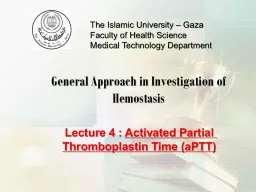PPT-General Approach in Investigation of
Author : sherrill-nordquist | Published Date : 2017-12-18
Hemostasis Lecture 4 Activated Partial Thromboplastin Time aPTT The Islamic University Gaza Faculty of Health Science Medical Technology Department Also known
Presentation Embed Code
Download Presentation
Download Presentation The PPT/PDF document "General Approach in Investigation of" is the property of its rightful owner. Permission is granted to download and print the materials on this website for personal, non-commercial use only, and to display it on your personal computer provided you do not modify the materials and that you retain all copyright notices contained in the materials. By downloading content from our website, you accept the terms of this agreement.
General Approach in Investigation of: Transcript
Download Rules Of Document
"General Approach in Investigation of"The content belongs to its owner. You may download and print it for personal use, without modification, and keep all copyright notices. By downloading, you agree to these terms.
Related Documents














